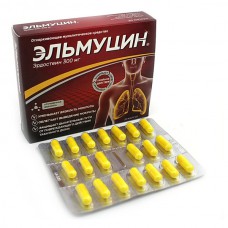Expiration date: 05/2027
Composition
Capsules, active substance:
erdosteine 300 mg
excipients: MCC-13 mg; povidone K30-8 mg; magnesium stearate-3 mg
hard gelatin capsules (body and lid): titanium dioxide-1.3333%; dye quinoline yellow-0.9197%; dye "Sunny sunset" yellow-0.0044%; gelatin-up to 100%
Description of the dosage form
Solid gelatin capsules No. 1 with a yellow body and lid.
The contents of the capsules are white or almost white powder.
Pharmacodynamics
The effectiveness of Erdosteine is due to the action of active metabolites. Thiol groups of metabolites cause the rupture of disulfide bridges that bind glycoprotein fibers, which leads to a decrease in the elasticity and viscosity of sputum. As a result, Erdosteine enhances and accelerates the release of the respiratory tract from secretions, improves the secretory function of the epithelium and increases the efficiency of mucociliary transport in the upper and lower respiratory tract.
Erdosteine has an antioxidant effect and transfers free radicals. In particular, Erdosteine protects the respiratory tract from the damaging effects of cigarette smoke in relation to the inactivation of ?1-antitrypsin.
Erdosteine increases the concentration of IgA in the airway mucosa in patients with chronic obstructive airway diseases, and also reduces the suppressive effect of tobacco smoke on granulocyte function.
The effect of therapy with Erdosteine develops on the 3rd-4th day of treatment. Erdosteine does not contain free SH-radicals, so it does not have a damaging effect on the gastrointestinal tract, and the side effects from the digestive system do not differ from the effects of placebo.
Pharmacokinetics
Erdosteine is rapidly absorbed from the gastrointestinal tract and metabolized in the liver to 3 active metabolites, the most important of which is N-thiodiglycolyl-homocysteine (Metabolite 1, or M1). T1/2 is more than 5 hours. Repeated use of Erdosteine or food intake does not affect the pharmacokinetic parameters. Cmax in blood plasma is 3.46 mcg / ml, Tmax-1.48 h, AUC0-24 h-12.09 mg * h/l.
Erdosteine binds to plasma proteins by 64.5%. It is excreted in the form of inorganic sulfates through the kidneys and intestines.
In the case of impaired liver function, there is an increase in Cmax and AUC. It is possible to increase T1/2 with a pronounced violation of liver function. In renal failure, accumulation of metabolites is possible.
The testimony of the drug Elmucin ®
Diseases of the respiratory tract with the formation of viscous sputum (in complex therapy).
Contraindications
- hypersensitivity to the components that make up the drug;
- expressed violation of liver function;
- kidney failure;
- homocysteinuria (the drug is a source of homocysteine, so it is possible to disrupt the metabolism of amino acids in patients on a diet with a reduced content of free methionine);
- pregnancy (I trimester);
- breastfeeding period;
- children under 18 years of age.
With caution: diseases of the bronchi, accompanied by excessive accumulation of secretions.
Use during pregnancy and lactation
Preclinical studies have not revealed the embryotoxic effect of Erdosteine.
Experience with the use of Erdosteine during pregnancy and breastfeeding is limited. Therefore, the use of the drug is possible only as prescribed by a doctor in the second and third trimesters of pregnancy, if the intended benefit to the mother exceeds the potential risk to the fetus.
Side effects
The frequency of adverse reactions is presented according to the WHO classification: very common (?1/10 of cases); common (?1/100 and <1/10 of cases); infrequent (?1/1000 and <1/100 of cases); rare (?1/10000 and <1/1000 of cases); very rare (<1/10000 of cases); frequency unknown.
From the gastrointestinal tract: rarely-heartburn, nausea, diarrhea; very rarely-nausea, pain in the epigastric region, loss or change in taste sensitivity at the beginning of treatment.
From the skin and subcutaneous tissues: rarely-allergic reactions: redness of the skin, edema, eczema; angioedema.
From the respiratory system, chest and mediastinum: very rarely — shortness of breath.
Interaction
When used simultaneously, Erdosteine increases the concentration of amoxicillin in the bronchial secretions, which allows for a faster response to therapy compared to monotherapy with amoxicillin.
Dosage and administration
Inside. 1 capsule (300 mg) 2 times a day. If there is no improvement within 5 days after starting the drug or there is a deterioration, you should consult your doctor.
Overdose
No overdose cases have been reported. However, in cases of overdose or accidental use by children, gastric lavage and symptomatic therapy are recommended.
Special instructions
During treatment, it is necessary to take a sufficient amount of liquid, which increases the expectorant effect. In cases of impaired bronchial motility or with a significant amount of sputum excreted, the use of the drug requires caution, due to the risk of delayed discharge in the respiratory tract and an increased risk of infection or bronchospasm.
Influence on the ability to drive vehicles, mechanisms. It does not affect the ability to drive vehicles, mechanisms and engage in other activities that require increased concentration of attention and speed of psychomotor reactions.
Release form
Capsules, 300 mg. 10 or 20 caps. in a contour cell package made of PVC film and aluminum foil printed lacquered. 1, 2, 3, 4 contour cell packages are placed in a pack of cardboard.
Manufacturer
JSC "Pharmaceutical company "Obolensky", Russia. 142279, Moscow region, Serpukhov district, village. Obolensk, building 7-8, building 39.
The organization that accepts the claims. JSC "Pharmaceutical company "Obolensky", Russia.
Conditions of release from pharmacies
Without a prescription.
Storage conditions of the drug Elmucin ®
At a temperature not exceeding 25 °C.
Keep out of reach of children.
The shelf life of the drug Elmucin ®
3 years.
Do not use after the expiration date indicated on the package.


